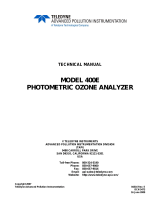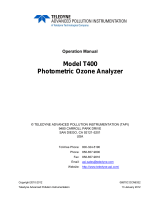Page is loading ...

®
77 Series III
Multimeter
Service Manual
PN 800604
November 1998 Rev.1, 11/99
© 1998,1999 Fluke Corporation. All rights reserved. Printed in U.S.A.
All product names are trademarks of their respective companies.

i
Table of Contents
Chapter Title Page
1 Introduction and Specifications................................. 1-1
1-1. Introduction ................................................................. 1-3
1-2. Organization of the Service Manual ........................... 1-3
1-3. Conventions ................................................................ 1-4
1-4. Specifications .............................................................. 1-4
2 Theory of Operation.................................................... 2-1
2-1. Introduction ................................................................. 2-3
2-2. Functional Block Description ..................................... 2-3
2-3. Detailed Description ................................................... 2-3
2-4. Voltage Signal Conditioning .................................. 2-3
2-5. Current Conditioning .............................................. 2-4
2-6. Ohms ....................................................................... 2-4
2-7. Additional Circuitry ................................................ 2-4
2-8. AC Converter ..................................................... 2-5
2-9. Active Filter ....................................................... 2-5
2-10. Rotary Switch ..................................................... 2-5
2-11. A/D Conversion .................................................. 2-5
3 Maintenance ................................................................ 3-1
3-1. Introduction ................................................................. 3-3
3-2. PCA Access and General Maintenance ...................... 3-3
3-3. Display Access ............................................................ 3-4
3-4. Cleaning ...................................................................... 3-4
3-5. Performance Test ........................................................ 3-7
3-6. Initial Procedure ..................................................... 3-7
3-7. DC Voltage Test ..................................................... 3-7
3-8. AC Voltage Test ......................................................... 3-8
3-9. Resistance Test ....................................................... 3-8

77 Series III
Service Manual
ii
3-10. Diode Test .............................................................. 3-9
3-11. DC mA Test ............................................................ 3-10
3-12. DC Amps Test ........................................................ 3-11
3-13. Calibration .............................................................. 3-11
3-14. Troubleshooting .......................................................... 3-11
3-15. Supplemental Troubleshooting Procedures ............ 3-13
3-16. Checking the Crystal Oscillator ......................... 3-13
3-17. Checking The Reference Voltage ...................... 3-13
3-18. Checking Display Drive Voltage ....................... 3-13
3-19. Checking Beeper Drive Signal ........................... 3-13
3-20. Tracing the VDC Signal Path ............................. 3-13
4 List of Replaceable Parts............................................ 4-1
4-1. Introduction ................................................................. 4-3
4-2. How to Obtain Parts .................................................... 4-3
4-3. Newer Instruments ...................................................... 4-3
4-4. Service Centers ........................................................... 4-3
4-5. Manual Status Information ......................................... 4-4
4-6. Parts Lists .................................................................... 4-4
5 Schematic Diagrams................................................... 5-1

iii
List of Tables
Table Title Page
1-1. Specifications ..................................................................... 1-5
2-1. S1 Function Codes.............................................................. 2-6
3-1. Recommended Test Equipment.......................................... 3-3
3-2. DC Voltage Test................................................................. 3-8
3-3. AC Voltage Test................................................................. 3-8
3-4. Resistance Test................................................................... 3-10
3-5. DC mA Test........................................................................ 3-11
3-6. DC Amps Test.................................................................... 3-11
4-1. Final Assembly................................................................... 4-5
4-2. A1 Main PCA..................................................................... 4-7
5-1. Abbreviations ..................................................................... 5-3

77 Series III
Service Manual
iv

v
List of Figures
Figure Title Page
2-1. Overview ............................................................................ 2-3
2-2. AC and A/D Converter....................................................... 2-7
3-1. Assembly Details................................................................ 3-6
3-2. Troubleshooting Tree......................................................... 3-12
4-2. A1 Main PCA..................................................................... 4-9
5-1. A1 Main PCA..................................................................... 5-4

77 Series III
Service Manual
vi

SAFETY-1
OPERATOR SAFETY
INFORMATION
This instrument has been designed and tested in accordance with IEC
Publication 348, Safety Requirements for Electronic Measuring Apparatus. This
manual contains information and warnings which have to be followed by the
user to ensure safe operation and to retain the instrument in safe condition.
Warning statements identify conditions or practices that could result in
personal injury or loss of life.
Caution statements identify conditions or practices that could result in damage
to the equipment or other property.
• Never use the meter if the meter or test leads look damaged.
• Always turn off power to the circuit before cutting, unsoldering, or breaking
the circuit. Small amounts of current can be dangerous.
• Never measure resistance in a circuit when power is applied to the circuit.
• Never touch the probes to a voltage source when the test leads are
plugged into the 10A or 300 mA input jack.
• Never apply more than 1000V dc or ac rms (sine) between any input jack
and earth ground.
• Always be careful when working with voltages above 60V dc or 30V ac
rms. Such voltages pose a shock hazard.
• Always keep your fingers behind the finger guards on the probe when
making measurements.
• Always use a high voltage probe to measure voltage if the peak voltage
might exceed 1000V.

SAFETY-2
Symbols Marked on Equipment
DANGER — High Voltage
Attention — refer to the manual. This symbol indicates that
information about the usage of a feature is contained in the
manual.
IFuse information
Use the Proper Fuse
To avoid fire hazard, use only the fuse identical in type, voltage
rating, and current rating as specified on the case bottom fuse rating
label.
Do Not Remove Cover
Always operate the meter with case top and bottom properly
assembled.
Access procedures and the warnings for such procedures are
contained in this Service Manual Service procedures are for qualified
service personnel only.
Do Not Attempt to Operate if Protection May be
Impaired
If the meter appears damaged or operates abnormally, protection may
be impaired. Do not attempt to operate it. When is doubt, have the
instrument serviced.

1-1
Chapter 1
Introduction and
Specifications
Contents Page
1-1. Introduction.................................................................. 1-3
1-2. Organization of the Service Manual............................ 1-3
1-3. Conventions ................................................................. 1-4
1-4. Specifications............................................................... 1-4

77 Series III
Service Manual
1-2

Introduction and Specifications
Introduction
1
1-3
1-1. Introduction
This manual presents service information for the Fluke 77 Series III
Multimeter. The manual includes a theory of operation, general maintenance
procedures, performance tests, calibration procedures, troubleshooting
information, a list of replaceable parts, and schematic diagrams.
A meter under warranty will be promptly repaired or replaced (at Fluke’s
option) and returned at no charge. See the registration card for warranty terms.
To locate an authorized service center, visit us on the World Wide Web:
www.fluke.com or call using any of the phone numbers listed below:
USA: 1-888-99-FLUKE (1-888-993-5853)
Canada: 1-800-36-FLUKE (1-800-363-5853)
Europe: +31 402-678-200
Japan: +81-3-3434-0181
Singapore: +65-738-5655
Anywhere in the world: +1-425-446-5500
1-2. Organization of the Service Manual
The following descriptions briefly describe each chapter in the manual.
Chapter 1 Introduction and Specifications
This chapter describes use of the Service Manual and application of special
terminology (conventions) to describe the meter’s circuitry. A complete set of
specifications appears at the end of this chapter.
Chapter 2 Theory of Operation
This chapter first categorizes instrument circuitry into functional blocks, with
a description of each block’s role in overall operation. A detailed circuit
description is then given for each block. These descriptions explore operation
to the component level and fully support troubleshooting and repair
procedures defined in Section 3.
Chapter 3 Maintenance
Provides complete maintenance information, from general maintenance and
cleaning instructions to detailed troubleshooting and repair procedures to the
component level. Troubleshooting and repair procedures rely heavily on both
the Theory of Operation presented in Chapter 2 and the Schematic Diagrams
shown in Section 5.
Chapter 4 List of Replaceable Parts
Includes parts lists for all standard assemblies. Information on how and where
to order parts is also provided.
Chapter 5 Schematic Diagrams
Includes schematic for the A1 Main PCA.

77 Series III
Service Manual
1-4
1-3. Conventions
Through the manual, certain notational conventions are used. A summary of
these conventions follow:
• Instrument Reference
The Fluke 77 Series III Multimeter is also referred to throughout this
manual as “the meter”.
• Printed Circuit Assembly
The term “pca” is used to represent a printed wiring board and its
attached parts.
• Circuit Nodes
Individual pins or connections on a component are specified by a dash
(-) following the component reference designator. For example, pin 19
of U30 would be U30-19.
• User Notation
Generally, push buttons, function positions, input terminals, and
display notation are presented in this manual as they are seen on the
meter.
Special terms (mnemonics) used in text descriptions of meter circuitry
correspond to terms used on the schematic diagrams in Chapter 5.
1-4. Specifications
Specifications for the meters are presented in Table 1-1.

Introduction and Specifications
Specifications
1
1-5
Table 1-1. Specifications
Maximum Voltage Between any
Terminal and Earth Ground Rated voltage
Display Digital: 3,200 counts, updates 2.5/sec
Analog: 31 segments, updates 25/sec
Response Time of Digital Display V ac < 2 s
V dc < 1 s
Ω < 1s to 320 kΩ, < 2s to 3.2 MΩ,
< 10 s to 32 MΩ
Operating Temperature 0°C to 50°C
Storage Temperature -40°C to 60°C
Temperature Coefficient 0.1 x (specified accuracy)/°C
(<18°C or >28°C)
Electromagnetic Compatibility In
RF field of 3 V/m on all functions. Total accuracy = Specified accuracy
+ 0.1% of range.
Relative Humidity
except 32 MΩ range
32 MΩ range only
0% to 90% (0°C to 35°C)
0% to 70% (35°C to 50°C)
0% to 80% (0°C to 35°C)
0% to 70% (35°C to 50°C)
Altitude Operating: 2000 meters
Storage: 12,000 meters
Battery Type 9 V NEDA 1604 or 6F22 or 006P,
or NEDA 1604A or 6LR61
Battery Life 2000 hrs typical with alkaline
1600 hrs typical with carbon zinc
Continuity Beeper 4096 Hz
Shock, Vibration per MIL-T-PRF 28800F Class III, Sinusoidal,
Non Operating
Size (H x W x L) 3.7 cm x 8.9 - 7.8 cm x 19 cm
(1.5 in x 3.5 - 3.1 in x 7.49 in)
Weight 365 g (12.9 oz)
Safety 600 V CAT III and 1000 V CAT II per
ANSI/ISA S82.01-1994, EN 61010-1: 1993,
CSA C22.2 No 1010.1-92, UL 3111-1.
EMC Regulations EN 61326-1 1997.
Certifications/Listings

77 Series III
Service Manual
1-6
Table 1-1. Specifications (cont)
Function Range Accuracy
L3.200 V
32.00 V
320.0 V
1000 V
±(0.3%+1)
±(0.3%+1)
±(0.3%+1)
±(0.4%+1)
mL320.0 mV ±(0.3%+1)
K (45 to 500 Hz,
3.2 V range. Other
ranges 45 to 1
kHz)
3.200 V
32.00 V
320.0 V
1000 V
±(2%+2)
±(2%+2)
±(2%+2)
±(2%+2)
e320.0 Ω
3200 Ω
32.00 kΩ
320.0 kΩ
3.200 MΩ
32.00 MΩ
±(0.5%+3)
±(0.5%+1)
±(0.5%+1)
±(0.5%+1)
±(0.5%+1)
±(2.0%+1)
G R2.0 V ±(1% typical)
Function Range Accuracy Burden Voltage
(typical)
? (45 Hz to 1 kHz) 32.00 mA,
320.0 mA
10.00 A *
±(2.5%+2)
±(2.5%+2) 6 mV/mA
50 mV/A
A32.00 mA,
320.0 mA
10.00 A *
±(1.5%+2)
±(1.5%+2) 6 mV/mA
50 mV/A
* 10 A continuous, 20 A for 30 seconds maximum.

Introduction and Specifications
Specifications
1
1-7
Overload protection for all functions and ranges: Rated voltage.
Function Input Impedance (Nominal)
L, mL, K>10 MΩ, <50 pF
Common Mode Rejection
Ratio (1 kΩ Unbalanced) Normal Mode Rejection
L, mL>120 dB at dc, 50 Hz, or 60 Hz >60 dB at 50 Hz or 60 Hz
K>60 dB dc to 60 Hz
Open Circuit Test Voltage Full Scale Voltage
To 3.2 MΩ 32 MΩ
e<3.1 V dc
<2.8 V dc (typical) <440 mV dc
<420 mV dc
(typical)
<1.4 V dc
<1.3 V dc
(typical)
Open Circuit Test Voltage Full Scale Voltage
G R<3.1 V dc 2.0 V dc
Short Circuit Current (typical)
e300 µA
G R400 µA
GVFCurrent (typical)
0.0 V
0.6 V
1.2 V
2.0 V
0.4 mA
0.3 mA
0.2 mA
0.1 mA

77 Series III
Service Manual
1-8

2-1
Chapter 2
Theory of Operation
Contents Page
2-1. Introduction.................................................................. 2-3
2-2. Functional Block Description...................................... 2-3
2-3. Detailed Description.................................................... 2-3
2-4. Voltage Signal Conditioning................................... 2-3
2-5. Current Conditioning............................................... 2-4
2-6. Ohms........................................................................ 2-4
2-7. Additional Circuitry................................................. 2-4
2-8. AC Converter ...................................................... 2-4
2-9. Active Filter ........................................................ 2-5
2-10. Rotary Switch...................................................... 2-5
2-11. A/D Conversion................................................... 2-5

77 Series III
Service Manual
2-2

Theory of Operation
Introduction
2
2-3
2-1. Introduction
This chapter contains a brief overview of the 77 Series III Multimeter,
followed by a more detailed explanation of operation.
2-2. Functional Block Description
The heart of the instrument consists of a two-chip CMOS system: U1, a
primarily analog IC, and U2, a calculator-style microcomputer (see Figure 2-
1).
OHMS
300 mV
DCV
ACV
OFF
ACmV
DCmV
A/D
J1
Input
Signal
Conditioning
Range and
Function
Control
To Bar
Graph To Digital
Display
LCD
S1
U2 Microcomputer
A/D Samples
Y1
32.768
kHz
Counter
U1 Analog Chip
V
REF
aaa01f.eps
Figure 2-1. Overview
2-3. Detailed Description
The following paragraphs describe the 77 Series III Multimeter in more detail.
While reading this description, refer to the schematic diagram in Chapter 5.
2-4. Voltage Signal Conditioning
Input divider Z1 and dc blocking capacitor C1 make up an input voltage signal
conditioning circuit.
/





